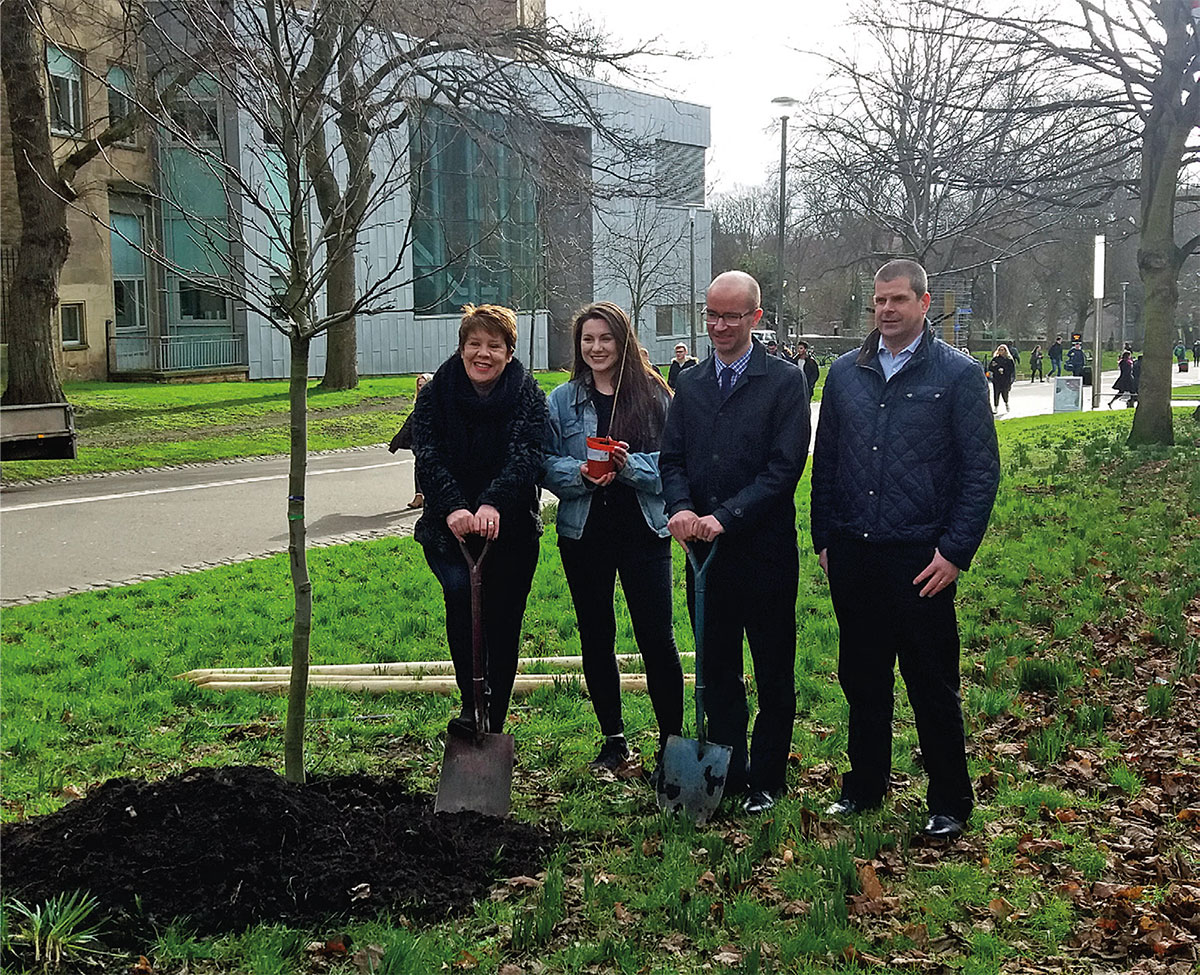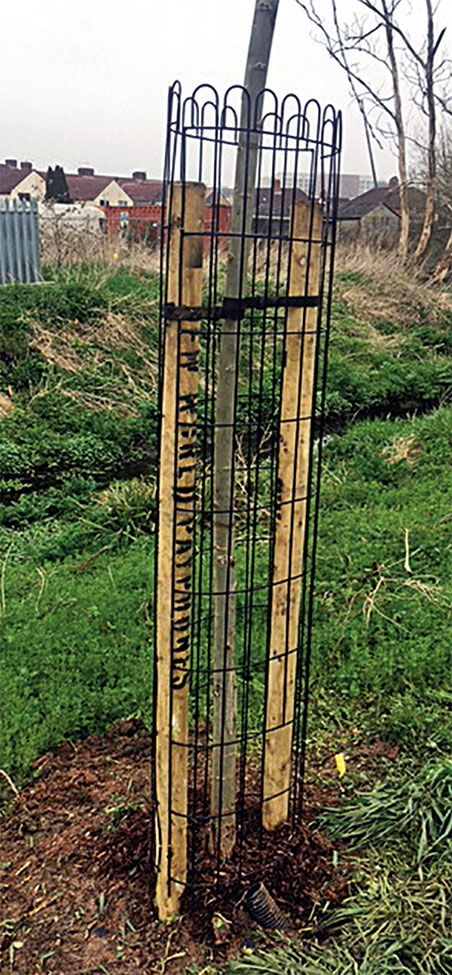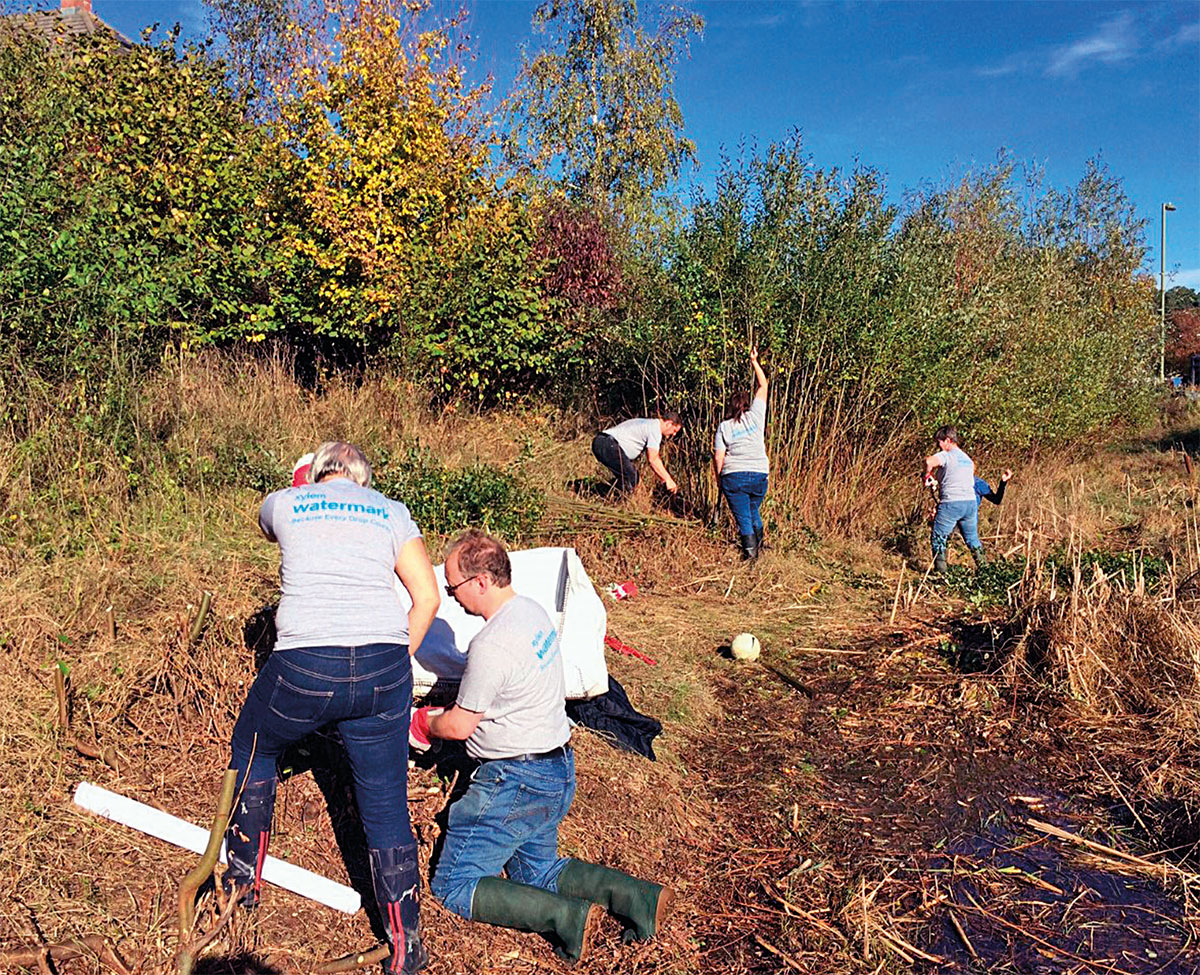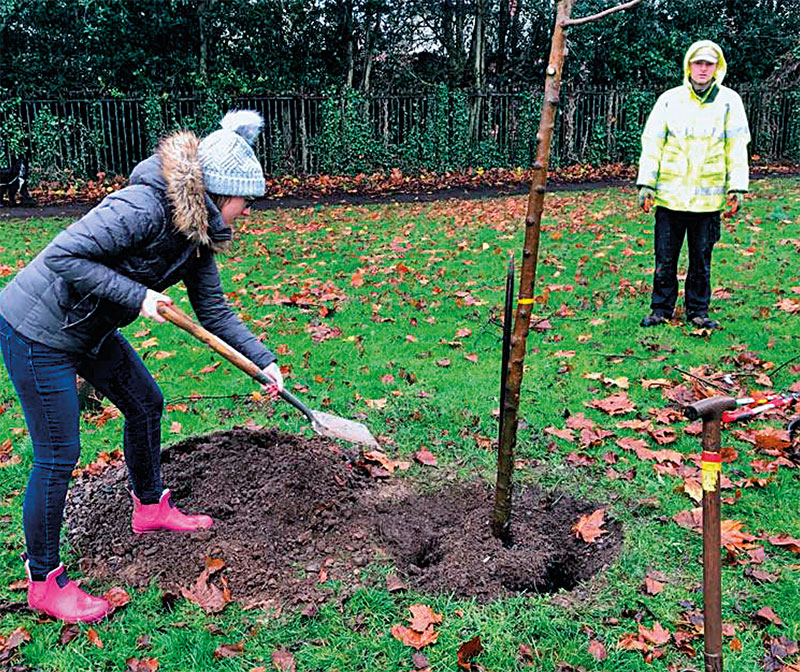
by Helen Davies Passionate about enhancing green infrastructure in our cities, I’ve spent the past three years undertaking a PhD at the University of Southampton looking at how to increase funding for urban trees. There is now a wealth of research showing how the right trees in the right places can help mitigate city problems […]
Could businesses help fund our urban trees?
by Helen Davies
Passionate about enhancing green infrastructure in our cities, I’ve spent the past three years undertaking a PhD at the University of Southampton looking at how to increase funding for urban trees.
There is now a wealth of research showing how the right trees in the right places can help mitigate city problems such as surface water flooding, air pollution, and the urban heat island, whilst also enhancing human wellbeing.1 However, there is little published information to suggest that urban forests in the UK are being planned and managed with these benefits in mind.
In 2016, I interviewed local authority tree officers from 15 of the UK’s largest and most densely populated cities (outside of London) to find out whether provision of ecosystem services is an objective of urban forest management, and if not, what could be done to address this.2 The tree officers were as passionate about the benefits of trees as I am; however, I was dismayed to find that due to limited (and seemingly ever dwindling) financial resources almost all of them are forced to manage their urban forests reactively, in response to complaints and safety risks. Even more worryingly, there was a strong perception amongst the tree officers that other council departments, politicians, businesses and citizens do not care about trees, and are not aware of the benefits they provide.
When I asked the tree officers what would facilitate their taking an ‘ecosystems approach’ to urban forest management, three opportunities were put forward. Firstly, raising awareness of the benefits of the local tree resource through i-Tree Eco studies (or similar).3 Secondly, adopting forwardthinking tree and woodland strategies. And finally, obtaining additional funding for tree planting and maintenance from those who benefit, such as businesses and citizens. One-third of those interviewed already receive small, ad hoc contributions to their budget from sponsorship or corporate social responsibility activities, but this has so far been insufficient for sustained tree planting. As such, the majority of tree officers were keen to explore the potential for novel funding streams such as a targeted, public-private ‘payments for ecosystem services’ (PES) scheme.
PES, in a nutshell, involves those who use or benefit from nature’s services giving payments to the providers (or stewards) of those services. Increasingly common in rural areas in countries worldwide, PES schemes based entirely in urban areas are rare – particularly those funded by businesses. Some researchers have suggested this is likely to be because of the complexity of urban environments, with fragmented habitats, a multitude of different landowners, and numerous stakeholders potentially hoping to free-ride on the contributions of others.
During 2012–15, the UK government funded three urban PES pilot projects to test the of PES in new contexts, two of which were successful in enticing private sector funders.4 For example, in the northern city of Hull, the local water company was willing to pay land managers to reduce flood risk through better management of green infrastructure. In the southern town of Luton, the local water company, two large businesses, and some local residents were willing to contribute to enhancing the amenity, recreation, biodiversity, water quality, and flood regulation services provided by a riparian park. However, the pilot in the city of Manchester was unsuccessful, due to inadequate incentives amongst interviewed businesses to fund improvements to the river in return for enhanced aesthetics, water quality, biodiversity, recreation, or flood or heat regulation.
In terms of corporate funding of urban forestbased ecosystem services, I have not identified any schemes labelled as PES. The nearest example I came across in the UK is Tree Time,5 a social enterprise set up in 2015 offering corporate sponsorship packages to support tree planting in Edinburgh. However, there has been limited take-up by the private sector, and Tree Time is soon to be re-launched with a focus on contributions from individuals.
Three similar schemes have been set up outside of the UK in the past year or so. City Forest Credits6 is a non-profit organisation that has had success attracting private sector buyers for tree planting across the United States; whilst the PadovaO27 project in Italy has so far planted 2,500 city trees from €50,000 of business donations. However, the Urban Forest Fund8 in Melbourne, Australia, has received interest from local residents, rather than businesses. I therefore decided to focus the remainder of my research on looking into the feasibility of beneficiary-funded urban forest PES schemes, using the city of Southampton as a case study.
New urban trees funded by Investec through Tree Time Edinburgh. (Photo: Richard Darke)
Radisson staff carrying out voluntary tree maintenance work at an urban site in Bristol. (Photo: Bristol City Council)
In 2017, I conducted questionnaire-based interviews with 30 businesses of varying sizes and sectors to ascertain their level of interest in a possible business-funded urban forest PES scheme in Southampton.9 I was very pleasantly surprised, both by their knowledge of a range of regulating and cultural ecosystem services, and by their positive attitudes towards investing in the planting and maintenance of urban trees.
In sharp contrast to the tree officers’ perceptions that companies ‘wouldn’t care’ about ecosystem services, those in Southampton rated tree benefits as significantly more important to their businesses than tree nuisances. The business respondents considered trees to be particularly beneficial regarding aesthetic beauty, air purification, and employee health and wellbeing. Six respondents even suggested that urban trees in the vicinity of their premises bring them financial rewards, for example through higher staff productivity, fewer sick days, and attracting additional customers.
The interviewed businesses clearly appreciate the benefits they receive from the city’s trees, but would they really invest money to prolong these benefits? 90% of respondents agreed in principle to private sector contributions to the urban forest, and 94% thought a publicprivate PES scheme would be feasible. Half of the businesses even considered it their ‘moral duty’ to invest in their local environment, and further, that societal benefits would be a strong driver of their involvement.
Some international studies, however, have suggested that intrinsic motivations alone are rarely sufficient to sustain corporate investment in social and environmental projects. I found this was also the case for the Southampton businesses. For example, the thought of mandatory contributions did not appeal to many of the interviewees; the smaller businesses were particularly concerned about the financial burden of an ‘extra tax’. This perhaps gives the impression – and this did cross my mind – that businesses will support a PES scheme in theory, but then when it comes to paying they may make their excuses and take advantage of the generosity of others.
There was in fact a very good reason for their preference towards a voluntary scheme, which again supports the findings of other studies. By far the greatest motivation for involvement in an urban forest PES scheme in Southampton was the commercial benefits it would bring to the company through enhancing their image and reputation. Meeting corporate social responsibility (CSR) objectives was the second greatest motivator. As one respondent said:
While this may appear self-centred, these are businesses we’re talking about, not charities. They exist to make money, and expect returns (though not always financial) on their investments. So a winwin scenario is no bad thing, and if this is what it takes to increase funding for our urban forests, then it gets my vote.
Of course, not every business will be as aware of the benefits of trees as those who took part in my study. To facilitate large-scale business funding of urban forest-based ecosystem services, clear communication of the likely environmental, social and economic benefits will be required, drawing on both scientific evidence and the experience of similar initiatives worldwide.
New urban trees in Bristol sponsored by New World Payphones. (Photo: Bristol City Council)
Xylem staff carrying out voluntary conservation work in an urban site in Basingstoke. (Photo: Basingstoke & Deane Borough Council)
According to the scientific literature, there are important aspects to consider when designing a PES scheme if it is to be successful. These are discussed below in the context of my Southampton study.
Firstly, which ecosystem services are being targeted, and (how) will they be measured? The businesses I interviewed in Southampton were most interested in funding tree planting and maintenance aimed at enhancing air quality. Paying to reduce flood risk and to improve aesthetics, employee wellbeing, and wildlife habitat were also of interest to at least two-thirds of those interviewed. However, the majority of businesses showed no interest in the monitoring of ecosystem service delivery to prove that they would be getting what they paid for, with some suggesting that this would add unnecessary costs to the scheme. Most businesses would be content with receiving information on the number of trees that are planted – and importantly, that survive.
Secondly, what form will the payments take, and at what spatial scale will the scheme operate? If businesses would be entering the scheme voluntarily, then those in Southampton would prefer to choose from a list of location specific projects to fund directly, as this would help with CSR reporting, marketing, and engagement of staff. I suggested that the PES scheme would operate city-wide, but only 40% of respondents would be interested in contributing to the city’s trees as a whole; 60% would prefer to invest only in trees in the immediate vicinity of their business premises in order to ensure direct as well as indirect benefits (though of course this isn’t necessarily the best way to utilise trees in ecosystem service delivery). If business involvement in the scheme was mandatory instead, respondents were evenly split between preferring payments to be based on company size vs. based on companies’ environmental impacts. In contrast, having a blanket rate equally payable by all businesses was not popular.
Thirdly, who holds the decision-making power over where and how the money is spent, and will inequalities in access to and use of trees and their benefits be reduced or exacerbated? One-third of the Southampton businesses wanted strong involvement in urban forest governance, ideally becoming part of a steering group, and even getting involved in the planting and maintenance work. However, the majority of respondents would be happy with minimal involvement, for example receiving annual updates regarding the tree planting projects they had helped to fund. Just over a quarter of respondents commented that trees should be planted in areas of need and/or where they are best suited, to avoid benefitting only the wealthy business districts.
Finally, will intermediaries (such as charities or NGOs) be involved? Intermediaries are common in PES schemes and have been found to improve coordination and trust between beneficiaries and ecosystem service providers. They can help to cover the costs of upfront canvassing, administration and transaction costs that are needed to get PES schemes off the ground. There was no requirement for an intermediary amongst the Southampton businesses, as they were willing to pay the council directly, but it is difficult to imagine an urban forest PES scheme getting underway without one. For example, though Southampton City Council was sufficiently interested in the results of this study to call a meeting with me, due to capacity and financial issues they would unfortunately only be able to support an urban forest PES scheme if another party took the lead. It would be useful now to have a conversation with some tree/woodland and environmental charities.
New urban trees in Cardiff sponsored by Cardiff Holiday Homes (Photo: Cardiff City Council)
Around two-thirds of the tree officers and businesses I interviewed each thought that citizens should also contribute to the benefits they receive from the urban forest, whether this be through a tax, community-based grants, sponsorship, or voluntary work. Consequently, in 2018, I ran an online survey (comprising what is known as a ‘choice experiment’) with 362 of Southampton’s residents to determine their willingness-to-pay for urban forest-based ecosystem services.10 The vast majority of respondents (93%) were willing to contribute financially to my proposed, city-wide street tree planting programme. Though I won’t discuss the results in detail here, the average amount that respondents were willing to pay for the tax-based programme (including basic air purification, flood risk reduction, and aesthetic benefits) was £140 per household per year. I also discovered that uncertainty surrounding the likelihood of air quality and flood reduction benefits being delivered by trees reduced people’s willingness-to-pay. However, telling people about these uncertainties had less of an effect on their willingness-to-pay than did their own personal doubts about ecosystem services delivery.
The core finding of my research is that a public-private partnership between local authorities, businesses and citizens holds strong potential for improving both appreciation of and financial support for urban forests. The tree officers were keen to explore a beneficiary-pays approach, whilst both businesses and citizens were strongly supportive of contributing financially to tree planting and maintenance in Southampton, particularly for air purification benefits. I hope that my research will be of use to you as arboricultural professionals, and that it may help facilitate a move towards an ecosystems approach to urban forest planning, governance, management, and funding.
With thanks to my PhD funding bodies (the Engineering and Physical Sciences Research Council, the University of Southampton, the Scottish Forestry Trust, and Forest Research) and the tree officers, businesses and citizens who participated in my studies.

CEnv MIEMA ACIEEM is Principal Environmental Consultant at WSP, one of the world’s leading engineering firms.
She is responsible for integrating ecosystem services into environmental assessments of government plans and development projects. In her spare time, as well as finishing off her PhD(!), Helen volunteers as the Tree Warden for Basingstoke & Deane Borough Council.
1 H. Davies, K. Doick, P. Handley, L. O’Brien and J. Wilson (2017), ‘Delivery of Ecosystem Services by Urban Forests’: www.forestry.gov.uk/PDF/FCRP026.pdf/$FILE/FCRP026.pdf
2 H.J. Davies, K.J. Doick, M.D. Hudson and K. Schreckenberg (2017), ‘Challenges for tree officers to enhance the provision of regulating ecosystem services from urban forests’: doi.org/10.1016/j.envres.2017.03.020
3 i-Tree tools: www.itreetools.org/ and www.forestresearch.gov.uk/research/i-tree-eco/
4 Defra (2016), Payments for Ecosystem Services: Review of pilot projects, 2012–15: www.gov.uk/government/publications/payments-for-ecosystemservices-review-of-pilot-projects-2011-to-2013
5 Tree Time Edinburgh: www.tree-time.com/
6 City Forest Credits: www.cityforestcredits.org/
7 PadovaO2: www.wownature.eu/host/padova-o2/
8 Melbourne’s Urban Forest Fund: www.melbourne.vic.gov.au/community/greening-the-city/urban-forest-fund/Pages/urban-forest-fund.aspx
9 H.J. Davies, K.J. Doick, M.D. Hudson, M. Schaafsma, K. Schreckenberg and G. Valatin (2018), ‘Business attitudes towards funding ecosystem services provided by urban forests’: doi.org/10.1016/j.ecoser.2018.07.006
10 ‘Citizen attitudes towards a new tree planting programme in Southampton’: www.soton-tree.uk/
This article was taken form Issue 185 Summer 2019 of the ARB Magazine.